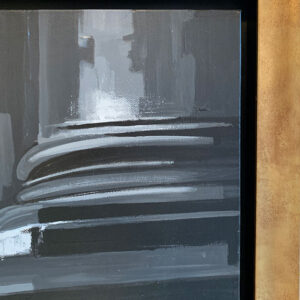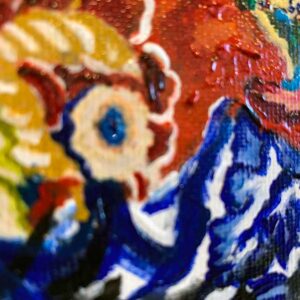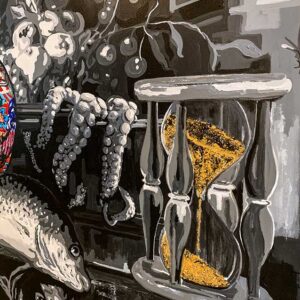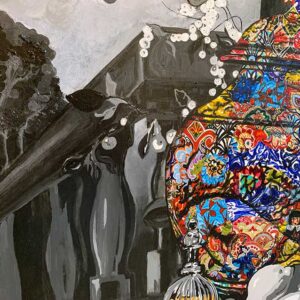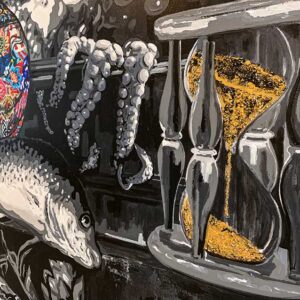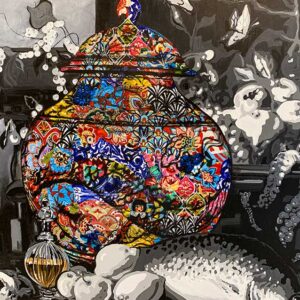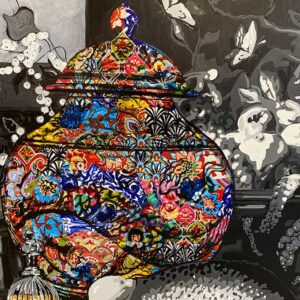Feast of Life
ACRYLIC ON CANVAS 150X100CM
Feasts have been used as a subject in works of art over the course of history, especially during the Italian renaissance. Culturally, feasts are celebratory occasions where people congregate to drink, eat and indulge themselves in loud banter and music. Due to this universal cultural significance, feasts have been used in art mostly to portray a scene where a story is being told and there are multiple characters involved. This can be seen in masterpieces like The Feast of Gods by Giovanni Bellini or in the Cassone panel by Bartolomeo di Giovanni.
In this oeuvre, the feast marks the culmination of the Psychomachia collection, where symbols that were used in previous paintings make a final reappearance. The eye is immediately drawn to the Pandora’s Box which is the centerpiece of the feast and it stands majestically while maintaining its aura of mystery and intrigue. The octopus that was featured in the piece, Nighttime Escape, can be seen with its tentacles clasped around the rim of a fruit bowl, making us wonder if it had finally found freedom or is it now tragically part of the feast. We also find ourselves being drawn to the Hourglass and the vessel containing Ambrosia, as they are highlighted in gold signifying their tremendous power.
This feast captures all the volatile forces that one has to face over the course of their life: be it the urge to make an escape from reality, the unstoppable nature of time or the undeniable realization of our mortality. This piece provides us with a visual representation of how much food for thought life offers to us and makes us wonder whether we are ready to join the feast.
Feast of Life
ACRYLIC ON CANVAS 150X100CM
Feasts have been used as a subject in works of art over the course of history, especially during the Italian renaissance. Culturally, feasts are celebratory occasions where people congregate to drink, eat and indulge themselves in loud banter and music. Due to this universal cultural significance, feasts have been used in art mostly to portray a scene where a story is being told and there are multiple characters involved. This can be seen in masterpieces like The Feast of Gods by Giovanni Bellini or in the Cassone panel by Bartolomeo di Giovanni.
In this oeuvre, the feast marks the culmination of the Psychomachia collection, where symbols that were used in previous paintings make a final reappearance. The eye is immediately drawn to the Pandora’s Box which is the centerpiece of the feast and it stands majestically while maintaining its aura of mystery and intrigue. The octopus that was featured in the piece, Nighttime Escape, can be seen with its tentacles clasped around the rim of a fruit bowl, making us wonder if it had finally found freedom or is it now tragically part of the feast. We also find ourselves being drawn to the Hourglass and the vessel containing Ambrosia, as they are highlighted in gold signifying their tremendous power.
This feast captures all the volatile forces that one has to face over the course of their life: be it the urge to make an escape from reality, the unstoppable nature of time or the undeniable realization of our mortality. This piece provides us with a visual representation of how much food for thought life offers to us and makes us wonder whether we are ready to join the feast.
In this expansive oeuvre, we see curtains, coated in colorful patterns and swirls, being drawn away to reveal a surreal landscape filled with towering trees, lush shrubbery and an out of place yet splendid chandelier. The scene that greets our eyes beyond the curtains may seem inviting but its lack of colour appears to be ominous. Perhaps the colourlessness of the landscape heeds a warning that your imagination can help you escape reality, but at what cost?
It is the realities of life that sparks the creative spirit and our most primitive need to survive, trying to escape into the coaxing world of our imagination will only dull the vibrant colours of the human experience. These vibrant colours are reflected in the patterns of the curtains, as the curtains are the only real object in the whole artwork. As we are made to gaze off into the imaginarium’s grey horizon, we are faced with a question: why do we choose to escape into a make-belief world, when life itself has so much to offer? The imaginarium in this oeuvre asks us: are we ready to draw the curtains on our imaginariums, so we can finally face and triumph over the challenges in our lives?


